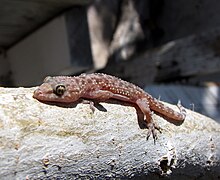Mediterranean house gecko
| Mediterranean house gecko | |
|---|---|
 |
|
| Scientific classification | |
| Kingdom: | Animalia |
| Phylum: | Chordata |
| Class: | Reptilia |
| Order: | Squamata |
| Suborder: | Sauria |
| Family: | Gekkonidae |
| Genus: | Hemidactylus |
| Species: | H. turcicus |
| Binomial name | |
|
Hemidactylus turcicus (Linnaeus, 1758) |
|
The Mediterranean house gecko (Hemidactylus turcicus) (not to be confused with the Asian species Hemidactylus frenatus known as common house gecko) is a small gecko common to the Mediterranean which has spread to many parts of the world. It is commonly referred to as the Turkish gecko as represented in its Latin name and also as the "Moon Lizard" because it emerges in the evening. A study in Portugal found H. turcicus to be totally nocturnal, with the highest activity peak around 2am. They are insectivorous, rarely exceeding 15 centimetres (5.9 in) in length, have large, lidless eyes with elliptical pupils, and purple - or tan-colored skin with black spots, often with stripes on the tail. Their bellies or undersides are somewhat translucent. In countries where the species has been introduced, they are not considered invasive due to their habits and small size; they rarely threaten populations of native animals.
In many parts of the world the range of H. turcicus is increasing, and unlike many other reptiles, they appear to be highly resistant to pesticides. The increase may be explained as a consequence of having few predators in places where they have been introduced, and also of their tendency to take shelter in the cracks and unseen areas of human homes, for example inside walls. Reliance on human habitation has thus contributed to their proliferation, similar to rodents. In some Eastern Mediterranean countries such as Turkey and Cyprus it is a taboo to harm them due to their benignant nature and they are often kept as house pets.
Snout rounded, about as long as the distance between the eye and the ear-opening, 1.25 to 1.3 the diameter of the orbit; forehead slightly concave; ear-opening oval, oblique, nearly half the diameter of the eye. Body and limbs moderate. Digits variable in length, the inner always well developed; 6 to 8 lamellae under the inner digits, 8 to 10 under the fourth finger, and 9 to 11 under the fourth toe. Head with large granules anteriorly, posteriorly with minute granules intermixed with round tubercles. Rostrum four-sided, not twice as broad as deep, with medial cleft above; nostril pierced between the rostrum, the first labial, and three nasals; 7 to 10 upper and 6 to 8 lower labials; mental large, triangular, at least twice as long as the adjacent labials, its point between two large chin-shields, which may be in contact behind it; a smaller chin shield on each side of the larger pair. Upper surface of body covered with minute granules intermixed with large tubercles, generally larger than the spaces between them, suboval, trihedral, and arranged in 14 or 16 pretty, regular longitudinal series. Abdominal scales small, smooth, roundish-hexagonal, imbricate. Males with a short angular series of 4 to 10 (exceptionally 2) preanal pores. Tail cylindrical, slightly depressed, tapering, covered above with minute scales and transverse series of large keeled tubercles, beneath with a series of large transversely dilated plates. Light brown or grayish above, spotted with darker; many of the tubercles white, lower surfaces white. They may be completely translucent except for the spotting. Some are darker. They often seek darkness when fleeing. They may be seen singularly or in a group ranging from 2 to 5 together.
...
Wikipedia

